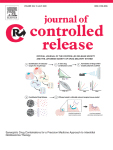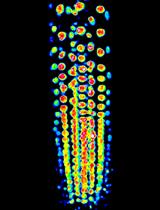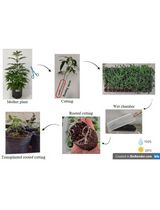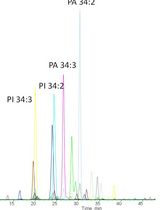- EN - English
- CN - 中文
Atomic Force Microscopy to Characterize Ginger Lipid-Derived Nanoparticles (GLDNP)
原子力显微镜研究生姜脂质纳米颗粒(GLDNP)
发布: 2021年04月05日第11卷第7期 DOI: 10.21769/BioProtoc.3969 浏览次数: 5141
评审: RAMESH KUDIRABrahma MuluguAnonymous reviewer(s)
Abstract
We have demonstrated that a specific population of ginger-derived nanoparticles (GDNP-2) could effectively target the colon, reduce colitis, and alleviate colitis-associated colon cancer. Naturally occurring GDNP-2 contains complex bioactive components, including lipids, proteins, miRNAs, and ginger secondary metabolites (gingerols and shogaols). To construct a nanocarrier that is more clearly defined than GDNP-2, we isolated lipids from GDNP-2 and demonstrated that they could self-assemble into ginger lipid-derived nanoparticles (GLDNP) in an aqueous solution. GLDNP can be used as a nanocarrier to deliver drug candidates such as 6-shogaol or its metabolites (M2 and M13) to the colon. To characterize the nanostructure of GLDNP, our lab extensively used atomic force microscopy (AFM) technique as a tool for visualizing the morphology of the drug-loaded GLDNP. Herein, we provide a detailed protocol for demonstrating such a process.
Keywords: Atomic force microscopy (原子力显微镜)Background
Developing new drug-based therapeutic approaches against Intestinal Bowel Disease (IBD) must overcome numerous challenges, including potential off-target effects, large-scale production costs, and the need to ensure tissue-specific delivery, systemic safety, and low toxicity. Our group and others have recently demonstrated that artificially synthesized nanoparticles could target low doses of drugs (e.g., siRNAs, proteins, or peptides) to colonic tissues or colonic immune cells, such as macrophages (Ulbrich and Lamprecht, 2010; Chen et al., 2017). However, these synthetic NPs to date have two major limitations: i) each constituent of the synthesized nanoparticle must be examined for potential in vivo toxicity before clinical application; and ii) the production scale is limited. The use of nanoparticles derived from natural sources may overcome these limitations. In this context, we reported that a special population of ginger-derived nanoparticles (GDNP-2) could reduce colitis and colitis-associated colon cancer (Zhang et al., 2016). Naturally occurring GDNP-2 is also safer and cheaper than synthetic NPs. We further identified 6-shogaol as a major candidate that may account for the anti-inflammatory and anti-cancer activities of GDNP-2 (Yang et al., 2020). To construct a nanocarrier that is more clearly defined than GDNP-2, we characterized ginger lipid-derived nanoparticles (GLDNP) and demonstrated that they could be used as a natural carrier to deliver natural anti-inflammatory drug candidates such as 6-shogaol, M2, or M13 to the colon and reduced colitis in mice (Yang et al., 2020).
Atomic force microscopy (AFM) is a versatile and powerful technique to characterize the morphology of nanoscale and submicron structured materials. It has been widely used to visualize different types of NPs, including metal-, inorganic- (non-metallic), and organic-NPs. AFM has the advantages of simplicity in sample preparation and no need for electric conducting treatment (Morris et al., 2010). In previous studies, our group and others have extensively used AFM to analyze the morphology and structure of GLDNP (Zhang et al., 2017; Wang et al., 2019; Sung et al., 2020; Yang et al., 2020). However, no attempt has been taken to document the procedure of sample preparation and AFM parameter setting. In the following protocol, we will use the GLDNP as the specimen to demonstrate the process of obtaining AFM pictures for nanostructure characterization.
Materials and Reagents
Pipette tips 0.1-10 μl, 1-200 μl and 100-1,000 μl (Sorenson Bioscience, catalog numbers: 70600 , 70520 , 70540 )
Powder-free gloves (Denville Scientific, catalog number: G4162 )
50 ml conical tubes (Denville Scientific, catalog number: C1062-P )
Phosphate-buffered Saline (PBS) (Corning, catalog number: 21-040-CV )
Methanol (Sigma-Aldrich, catalog number: 34860-1L-R )
Potassium chloride (KCl, Millipore, catalog number: 7447-40-7 )
Dichloromethane (Sigma-Aldrich, catalog number: 650463-1L )
Deionized-distilled water (ddH2O)
Mica sheet (Electron Microscopy Sciences, catalog number: 71855-15 )
1 M KCl solution (see Recipes)
Equipment
Pipettes 0.5-10 μl, 10-100 μl and 100-1,000 μl (Eppendorf, model: Research® Plus , Variable Adjustable Volume Pipettes)
Milli-Q advantage A10 water purification system (Millipore-Sigma, catalog number: C10117 )
Glass separatory funnel (Southern Labware, model: 3964-3)
Centrifuge (Thermo Fisher Scientific, model: Sorvalis ST16R )
Vortexer (Scientific Industries, model: 200-SI0236 )
Rotary evaporator (Buchi, model: R-210 )
Vacuum pump (Buchi, model: V-700 )
Vacuum controller (Buchi, model: V-800 )
Heating bath (Buchi, model: B-491 )
Evaporating flask (Buchi, catalog number: Z402982 )
Notebook computer (ThinkPad, model: T570 )
CoreAFM controller (Nanosurf, model: CoreAFM controller)
CoreAFM system (Nanosurf, model: CoreAFM system)
Isostage 300 controller (Nanosurf, model: Isostage 300 controller)
CoreAFM tool set (Nanosurf, model: CoreAFM tool set)
Software
CoreAFM control software (Version 3.10.0, https://www.nanosurf.net/en/software/coreafm)
Procedure
文章信息
版权信息
© 2021 The Authors; exclusive licensee Bio-protocol LLC.
如何引用
Long, D., Yang, C., Sung, J. and Merlin, D. (2021). Atomic Force Microscopy to Characterize Ginger Lipid-Derived Nanoparticles (GLDNP). Bio-protocol 11(7): e3969. DOI: 10.21769/BioProtoc.3969.
分类
癌症生物学 > 癌症生物化学 > 耐药性
植物科学 > 植物生物化学 > 代谢物
生物化学 > 其它化合物 > 可食用纳米颗粒
您对这篇实验方法有问题吗?
在此处发布您的问题,我们将邀请本文作者来回答。同时,我们会将您的问题发布到Bio-protocol Exchange,以便寻求社区成员的帮助。
提问指南
+ 问题描述
写下详细的问题描述,包括所有有助于他人回答您问题的信息(例如实验过程、条件和相关图像等)。
Share
Bluesky
X
Copy link












